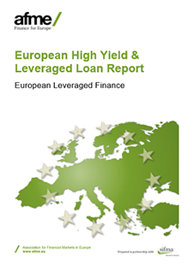The AFME High Yield Division is pleased to circulate the Quarterly Data Report for the first quarter of 2017 (the “Report”)
The Report contains European leveraged finance market trends for the first quarter of 2017, which includes issuance and credit performance figures for the high yield and leveraged loan markets.
Key highlights:
- European leveraged finance issuance (leveraged loans and high yield bonds) increased in 1Q’17 to €86.5 billion, a 50.5% increase from €57.4 billion in 4Q’16 and almost double the €43.5 billion issued in 1Q’16. This was the highest quarterly issuance since 2Q’14.
- Leveraged loan issuance increased to €50.8 billion in the first quarter of 2017, up 19.9% q-o-q (€42.4 billion in 4Q’16), up 54.2% y-o-y (€33.0 billion in 1Q’16). This was the highest quarterly total since the financial crisis.
Most of the loans issued in 1Q’17 were 1st lien loans; there were no mezzanine loans and one 2nd lien loan financed.
Pricing spreads for institutional loans widened by 12 basis points (bps) q-o-q and by 13 bps y-o-y while spreads for pro rata loans tightened by 27 bps q-o-q but by 12 bps y-o-y. - Primary high yield issuance in 1Q’17 totalled €35.7 billion on 76 deals, a 136.8% increase from 4Q’16 (€15.1 billion on 41 deals) and a 237.4% increase from 1Q’16 (€10.6 billion on 22 deals).
The proportion of USD-denominated issuance increased to 41.3% of all issuance in 1Q’17, compared to 29.1% in 4Q’16 and 28.2% in 1Q’16.
Issuance for refinancing and/or repayment of debt in developed market Europe decreased to €11.8 billion, representing 42.8% of all issuance in 1Q’17, up from €4.6 billion (45.4% of total) in 4Q’16 and from €1.3 billion (14.1% of total) in 1Q’16. In emerging market Europe, no high yield debt was issued for refinancing and/or repayment of debt in 1Q’17.
- Credit quality: According to S&P, upgrades exceeded downgrades in developed market Europe (37 upgrades to 16 downgrades), a much better ratio than 26 upgrades to 33 downgrades in 4Q’16 and 20 upgrades to 40 downgrades in 1Q’16. It was the lowest downgrade percentage of a total since 2Q’14.
Seven bond-related defaults were reported in the first quarter of 2017, six in developed market Europe and one in emerging market Europe.
Speculative-grade default rates stood at 2.1% according to S&P (up from 1.4% at end-December 2016) and 2.5% according to Moody’s (up from 2.1% at end-December 2016).




